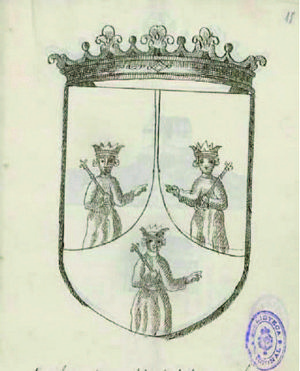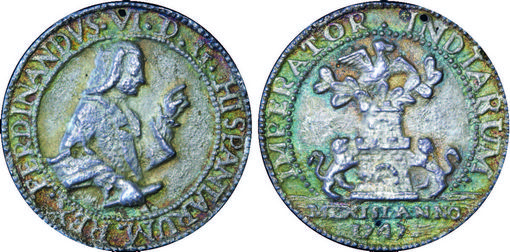An Unknown Proclamation Medal of Valladolid de Michoacán: Fernando VI(1747)
by Ricardo Vargas
Continuing my research on the proclamation medals of my beloved Michoacán, I stopped again in the city of Valladolid, today called Morelia, to investigate the oath to Fernando VI in 1747 and the ones to Carlos III in 1760 and 1761. The stories of the oaths to the kings are truly interesting, colorful, detailed and full of symbolism and, when it comes to numismatics, there are always small details that generate great revelations.
Before delving into the oaths of Fernando VI and Carlos III, I must mention that I was able to find evidence and documentation of acts of proclamation in Valladolid since Felipe IV in 1621 through Carlos II Morelia Municipal Historical Archive (AHMM), Manuscript Books, No. 2 (1616-1729), fs. 127-130v in 1666, Felipe V in 1701 and Luis I in 1724. All of those acts took place even when Pátzcuaro held the capital of the province of Michoacán. Valladolid had to wait for Pátzcuaro to hold its festivities first to be able to carry out the proclamation and with ceremonies of much smaller magnitude than those that took place in the lake city. For none of those proclamation acts did I find evidence of any medals made for the oath.
Since the beginning of the 18th century, to be precise in 1701, Valladolid and Pátzcuaro began a legal and propaganda war The propaganda war was reflected in the Gazetas de México No. 60, 79 and 80, an information medium for all of New Spain trying to be recognized as the capital of Michoacán. Although Pátzcuaro Henry Soto, Fiestas Reales y Pontificias en Pátzcuaro, CREFAL, Pátzcuaro, Mexico., 1991, p. 16 won the battle with regard to the swearing-in of Felipe V and Luis I, it would end up losing the war since Valladolid would definitively be crowned as the capital of Michoacán after the oath to Fernando VI.
The Oath to Fernando VI
The last battle between the cities occurred after the death of Felipe V. Both cities sent their arguments to the Viceroy so that he could decide who should take the oath (and be the capital of Michoacán); however, with little patience and the desire to succeed, the provincial mayor of Valladolid, D. Miguel Antonio de Pagola, explained to the Valladolid council that, regardless of the decision that would be made by the Viceroy as to the capital of Michoacán, Valladolid should do the proclamation “because His Majesty has not declared one way or the other whether the city of Pátzcuaro is to be the capital, it does not prevent each one of the cities from recognizing its King and Lord as it should ” AHMM, Manuscript Books No. 22 (1742-1759) fs.84-85..
The members of the Cabildo approved the motion made by Pagola and immediately got down to work collecting money and requesting reviews of the swearing-in made in Mexico City and Puebla, in order to take those festivities as a basis for planning the swearing-in of Ferdinand VI at the bicentennial Valladolid.
It was on 3 December 1747, when the people of Valladolid, at 4:00 in the afternoon, began the parade of the royal flag, led by the Regidor Decano, Colonel D. Luis Antonio Correa, who delivered the harangue from the platform:
“Castile, Castile, Castile, New Spain, New Spain, New Spain; Valladolid de Michoacán, Valladolid de Michoacán, Valladolid de Michoacán, for our undefeated King and natural Lord D. Fernando Sexto of this name, may God keep many years... to which the crowd would respond while the provincial mayor D. Miguel Antonio de Pagola, unveiled the royal portrait “Long live, long live, long live ”AHMM, Manuscript Books No. 22 (1742-1759) fs.84-85. You can also find it in Rivera Cambas, Manuel, México Pintoresco, Artístico y Monumental , Volume 3, Facsimile Edition, Editorial del Valle de México, 1989, pp. 448-451..
Guns were fired, rockets were launched, bells rang, and cheers were repeated over and over again as the Colonel and Aldermen launched:
 “... portion of coins that were carved for this purpose, having the royal Image carved on the
“... portion of coins that were carved for this purpose, having the royal Image carved on the
obverse and the arms of the city on the reverse...” Extract from the original book.
““A boy son of the colonel who was presented dressed as a military man for this act, threw those coins everywhere in the theater, and having thrown the coins, he also threw the chiseled silver tray … on which they were carried “Idem..
 The text specifies that the coins thrown were carved for this purpose, the Oath, and also describes them in a very concise but clear way: Fernando VI would be on one side and the coat of arms of the City on the other. In the image on the right you can see a coat of arms of Valladolid dated in 1767Current Arms of the City of Michoacán from Fernando Martínez de Huete, Collection of arms and coats of arms of the Hispanic monarchy in America. 1767. Royal Historical Archive of Latin America and Spain to get an idea of how it looked on a “close” date.
The text specifies that the coins thrown were carved for this purpose, the Oath, and also describes them in a very concise but clear way: Fernando VI would be on one side and the coat of arms of the City on the other. In the image on the right you can see a coat of arms of Valladolid dated in 1767Current Arms of the City of Michoacán from Fernando Martínez de Huete, Collection of arms and coats of arms of the Hispanic monarchy in America. 1767. Royal Historical Archive of Latin America and Spain to get an idea of how it looked on a “close” date.
Until today, there is no catalog that mentions a medal that commemorates the proclamation of Fernando VI in Valladolid de Michoacán, nor have I been able to locate a single image or drawing of the medal. I am not aware of the existence of any surviving piece.
The manufacture of the piece must have been of cast silver, as was customary at the time.
We know that Valladolid requested the reviews of the oaths from the cities of Mexico and Puebla, places where they also made medals in honor of Ferdinand VI and of which we do know survivors such as this specimen, cataloged in Grove as F6-3, from Mexico City. I think that this coin could probably have been the inspiration for the unknown medal of Valladolid.

Proclamation Medal of Mexico City to Ferdinand VI – Col. Alejando M. Bustos
I hope that if any of our colleagues know of any surviving medal of Fernando VI in Valladolid, they will share it with us to increase everyone’s knowledge.
I would like to thank my numismatic friend Jaime Alberto Vargas Chávez and Melba Maya Guz for all their support with the visit and digitization of the manuscript books of the colonial collection of the Historical Archive of the Municipality of Morelia.
